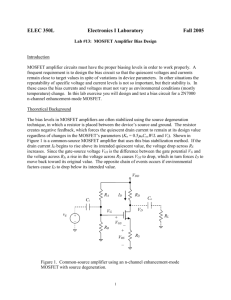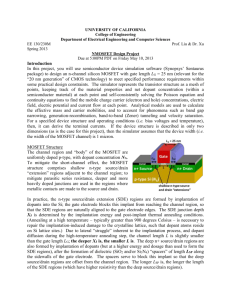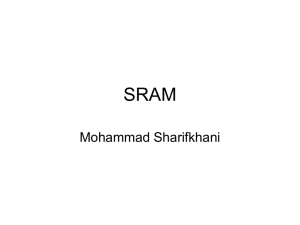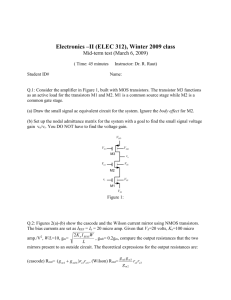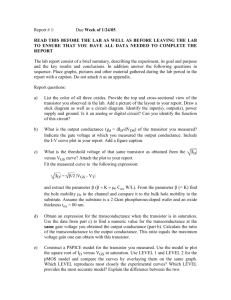MOSFET Biasing with Single Supply: Design & Optimization
advertisement
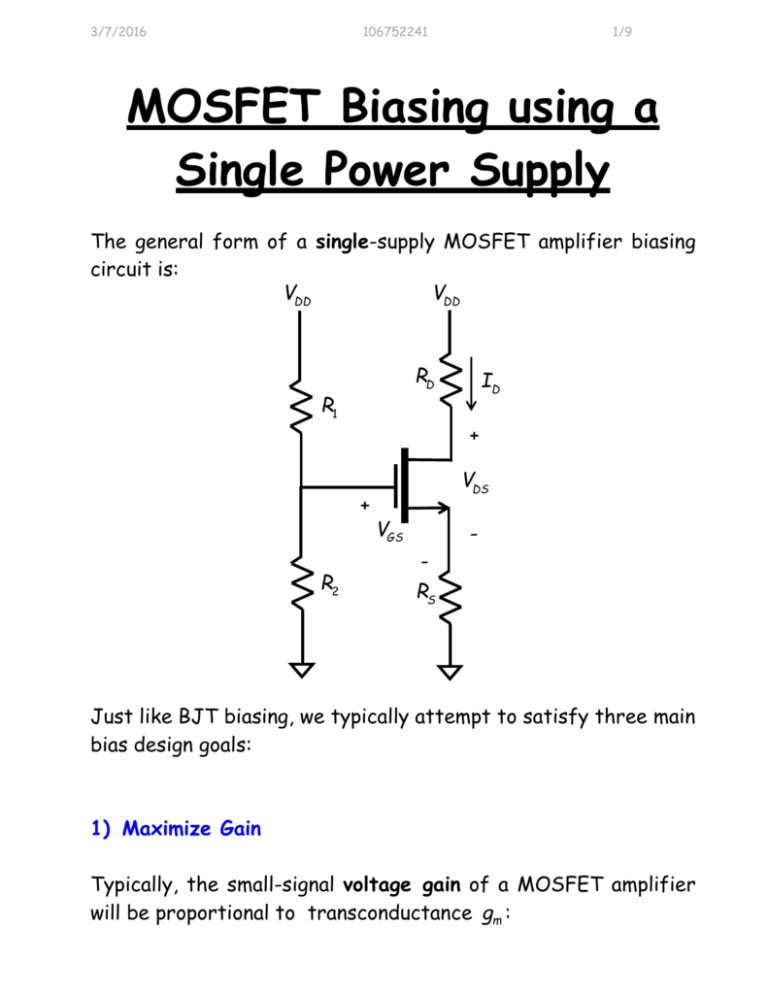
3/7/2016 106752241 1/9 MOSFET Biasing using a Single Power Supply The general form of a single-supply MOSFET amplifier biasing circuit is: VDD VDD RD R1 + + R2 ID VDS VGS - - RS Just like BJT biasing, we typically attempt to satisfy three main bias design goals: 1) Maximize Gain Typically, the small-signal voltage gain of a MOSFET amplifier will be proportional to transconductance gm : 3/7/2016 106752241 2/9 Avo gm Thus, to maximize the amplifier voltage gain, we must maximize the MOSFET transconductance. Q: What does this have to do with D.C. biasing? A: Recall that the transconductance depends on the DC excess gate voltage: gm 2 K VGS Vt Another way to consider transconductance is to express it in terms of DC drain current ID . Recall this DC current is related to the DC excess gate voltage (in satureation!) as: ID K VGS Vt 2 VGS Vt ID K And so transconductance can be alternatively expressed as: gm 2 K VGS Vt 2 K ID 2 K ID K Therefore, the amplifier voltage gain is typically proportional to the square-root of the DC drain current: Avo ID 3/7/2016 106752241 3/9 To maximize Avo , maximize ID 2) Maximize Voltage Swing Recall that if the DC drain voltage VD is biased too close to VDD , then even a small small-signal drain voltage vd (t ) can result in a total drain voltage that is too large, i.e.: vD (t ) VD vd (t ) VDD In other words, the MOSFET enters cutoff, and the result is a distorted signal! To avoid this (to allow vd (t ) to be as large as possible without MOSFET entering cutoff), we need to bias our MOSFET such that the DC drain voltage VD is as small as possible. Note that the drain voltage is: VD VDD RD ID Therefore VD is minimized by designing the bias circuit such that the DC drain current ID is as large as possible. 3/7/2016 106752241 4/9 However, we must also consider the signal distortion that occurs when the MOSFET enters triod. This of course is avoided if the total voltage drain-to-source remains greater than the excess gate voltage, i.e.: vDS (t ) VDS vds (t ) VGS Vt Thus, to avoid the MOSFET triode mode—and the resulting signal distortion—we need to bias our MOSFET such that the DC voltage VDS is as large as possible. To minimize signal distortion, maximize VDS 3) Minimize Sensitivity to changes in K ,Vt We find that MOSFETs are sensitive to temperature— specifically, the value of K is a function of temperature. Likewise, the values of K and threshold voltage Vt are not particularly constant with regard to the manufacturing process. Both of these facts lead to the requirement that our bias design be insensitive to the values of K and Vt . Specifically, we want to design the bias network such that the DC bias current does not change values when K and/or Vt does. 3/7/2016 106752241 5/9 Mathematically, we can express this requirement as minimizing the value: d ID d ID and dK dVt Similar to the BJT, we find that these derivatives are minimized by maximizing the value of source resistor RS . To minimize d ID dK , maximize RS So, let’s recap what we have learned about designing our bias network: 1. Make ID as large as possible. 2. Make VDS as large as possible. 3. Make RS as large as possible. Again analogous to BJT biasing, we find that these three goals are conflicting, as they are constrained by the KVL equation of the bias circuit: 3/7/2016 106752241 VDD 6/9 VDD RD R1 VDD ID RD VDS ID RS 0 + + R2 ID or VDS VGS - - ID RD VDS ID RS VDD RS Maximize Avo by maximizing this term. Minimize distortion by maximizing this term. Minimize sensitivity by maximizing this term. But the total of the three terms must equal this! 3/7/2016 106752241 7/9 Resolving this conflict is a subject choice of the amplifier designer. However, here is a “rule-of-thumb” procedure. However, verify that these results satisfy your design requirements (or the requirements assigned to you by your boss and/or professor!). 1. Given the desired value of ID, make source voltage VS VDD 4 , i.e. set the source resistor RS to: RS V Vs DD ID 4ID (1) This value reduces the sensitivity d ID dK ! 2. Now determine the required value of VGS . Since ID K (VGS Vt )2 , we find that VGS should be: VGS ID Vt K 3. Set the required value of gate voltage VG . Note that: VG VGS VS Thus, we can add the results of the previous two steps to find the required value of the gate voltage VG . 3/7/2016 106752241 8/9 To set the gate voltage to this value, we must select the proper values of resistors R1 and R2 . Since the gate current is zero (iG 0 ), we find from voltage division that: R2 VDD VG VDD R1 R2 R1 1 R2 (2) Note this equation determines the ratio of resistors R1 and R2 , but not the resistors themselves. We need a second equation to explicitly determine the resistors values—the sum of the two resistances, for example. We find that making the resistances R1 and R2 as large as possible is very desirable! This will typically maximize the amplifier input resistance, as well as result in minimum power dissipation. As a result, we make the resistors as large a practicable. For example: R1 R2 250 K (3) 4. Set the required value of DC drain voltage VD . Recall that: a) we require VD VDD L to avoid cutoff mode. 3/7/2016 106752241 b) and, we require that VD 9/9 VG Vt L to avoid triode mode. Solution: set the drain voltage VD to a value half-way between VDD and VG Vt ! In other words, set the DC drain voltage to be: VD VDD VG Vt 2 To achieve this, we must select the drain resistor RD so that: RD VDD VD VDD VG Vt ID 2ID Thus, use equations (1), (2), (3), and (4) to determine the standard DC bias design (i.e., R1, R2, RS , and RD ) for MOSFET amplifiers. If I were you, I’d make sure I understood this material well enough that I could also bias a non-standard MOSFET amplifier problem. It’s not enough to simply know how, you must also know why! (4)


